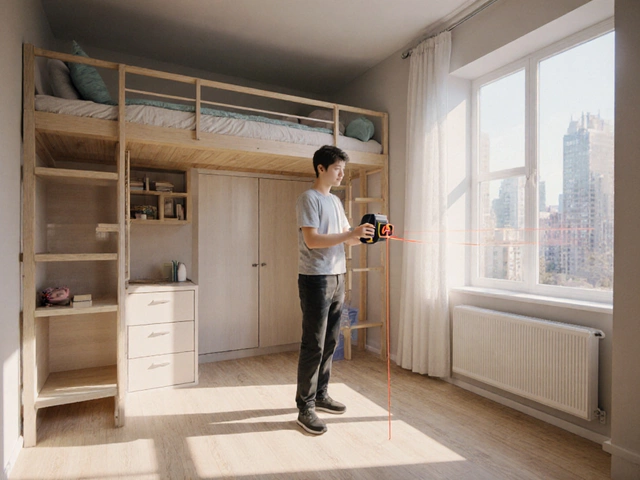Most Profitable Property Types: Insights for Real Estate Investment in 2025

Ask any Kiwi about investment, and you'll find property is always somewhere near the top of the list. But not all bricks and mortar are created equal. The question isn't whether property makes money—it’s which type makes the most. Gone are the days when you’d buy any house and expect magic. Today’s profits play out in different corners of the market, and sometimes where you least expect.
Understanding Today’s Property Profits
Back in the 90s, you could pick up a villa in central Auckland for a song, rent it out, and watch double-digit growth while sitting on the deck with a beer. Now, times have changed, and it’s a mixed bag. Rental yields, capital gains, risks, regulations—they all mix in ways that make one property type shine and another lag behind. For 2025, rental income and long-term appreciation still control the conversation.
Let’s get concrete. Auckland houses—the standard three-bed, two-bath on its own bit of dirt—still cost a bomb, with average prices floating north of $1.2 million as of June 2025. That means low yields, sometimes dipping below 3%, after costs. Apartments, on the other hand, offer higher yields, sometimes closer to 5%, but they bring body corp fees and, in central suburbs, intense competition. Commercial properties like small retail units or warehouses charm investors with promise of 6–8% yields, but with bigger risks like vacancies or downturns in business renting out space.
What’s driving these numbers? Demand, mostly. Kiwis love big homes, but the stuff that really pays right now tends to be niche: well-located multi-unit flats, suburban units close to transport, and some newer student accommodation. There’s talk about the rise of build-to-rent projects, too, with several in the pipeline for Auckland and Wellington. These are properties built specifically for long-term renters and designed to be easy to manage.
But while numbers matter, so do trends. With New Zealand’s population still inching upwards thanks to immigration and natural growth, the demand for both city apartments and suburban townhouses isn’t slowing down. Affordability pushes first-home buyers out, leaving rents and, in turn, investors with more power. Savvy property types check all these boxes—and still manage to be resilient against interest rate rises, which have rocked the mortgage market for owners and investors alike.
Residential Investments: Houses, Apartments, and Townhouses
Let’s break down the classic options most Kiwi investors stare at on TradeMe after dinner. Traditional standalone houses are still a favorite—easy to rent, a solid long-term bet, and always appealing to families. But high prices often mean the rental yields are low. You might see only a few hundred dollars a week after mortgage, rates, insurance, and maintenance—unless you’ve owned for decades or got lucky in a hot area.
Now, apartments are where the yield game gets interesting—especially in city centers. In Auckland’s CBD and fringe suburbs, small two-bedroom apartments can return upwards of 5% if bought right. You get more tenants (think students, young professionals, or couples), but you’ve got to factor in body corp fees—which, for older towers, sometimes hit $8,000 or more per year. The upside? Little to no garden maintenance. The downside? High concentration means if new towers go up, your rents or values might drop.
Townhouses, especially those built in the last 5–10 years, strike a neat balance. Medium density design is hot right now, thanks to zoning changes in Auckland, Hamilton, and Wellington. Many townhouses offer similar returns to apartments but with their own front doors—making them more appealing to young families, downsizers, and longer-term renters. These units often get snapped up quickly during viewings, especially those within walking distance to public transport or schools.
Want the best odds? Focus on location first—close to universities for student rentals, major business hubs for professionals, or leafy suburbs where families want good schools. Newer properties mean fewer maintenance headaches, but older properties on large sections sometimes allow you a value-add—like building a granny flat, subdividing, or just giving the place a facelift to boost the weekly rent by $100–$200.
One tip many miss: properties that appeal to pet owners. Landlords who allow pets (like me, with my dog Shadow and my cat Mia) earn more and find tenants faster. A 2023 survey by Barfoot & Thompson showed pet-friendly rentals commanded up to 15% higher rent and cut tenant turnover by nearly a third. Even a simple, fully-fenced garden can make your place the talk of the neighborhood among renters and investors alike.

Commercial, Industrial, and Short-term Stays
If you want to push past the basics, you’ve got commercial options. Shops, small office units, industrial sheds—these can tilt the profit scales when managed well. Average commercial property yields in Auckland sat around 6-8% in 2024, according to CBRE data. The sweet spot for many private investors has become small retail with good leases, or industrial warehouses in city fringe suburbs fuelled by the rise in e-commerce and logistics businesses needing storage.
But let’s not sugarcoat it: commercial can be risky. When COVID-19 hit, rents for high street shops collapsed. If your tenant goes bust or moves out, commercial units can sit empty for months and cost you a mint in lost income. Due diligence here is everything—knowing your tenant, the lease terms, and the local demand matters more than any spreadsheet. My mate in Mt Eden lost his shirt when a once-hailing café tenant shut their doors last year, but my cousin in Manukau tripled his investment in a warehouse after Amazon’s local logistics partner signed a 5-year lease.
If you like flexibility, short-term stays like Airbnb have changed the game for certain locations—Queenstown, Rotorua, central Auckland, and parts of Wellington. You can double or even triple weekly rent compared to traditional tenants. The catch? High turnover, housekeeping costs, local council restrictions (like the 90-day cap in many Auckland suburbs), and the ever-present risk that tourist numbers slump. Short-term lets work best in tourist hotspots and event-rich areas (think Eden Park or near big universities on graduation week). Make sure you stay on top of regulations, though—council clampdowns and new tax rules catch out the unprepared.
Industrial property—think storage units, auto repair bays, or even "man sheds"—has been a silent star for many Kiwi investors quietly earning more. They require less maintenance and fewer tenant dramas, and returns have stayed solid even when office or retail hit the skids. With the explosion of online shopping, these spaces are often snapped up before they hit the public listings.
Emerging and Niche Profitable Property Types
Some of the best profits lately have crept up on people. Student accommodation—especially high-quality rooms with shared spaces—has delivered stable returns in university-heavy towns like Dunedin and Wellington. Co-living spaces, where young professionals rent a private room and share living areas, keep vacancy rates low and rental yields up. Investors who pivoted early are laughing all the way to the bank.
New Zealand’s tiny home movement also deserves a mention. While it’s still a niche, some investors have pivoted to buying sections and placing one (or several) transportable tiny homes to rent out at a premium, especially in lifestyle hotspots like Wanaka and Raglan. The upshot? Lower upfront costs, high returns per square metre, and a unique selling point to younger tenants.
Retirement villages, or licensed rest-home units, have long been profitable for corporates. But smaller-scale investor opportunities exist with stand-alone homes modified for aged care or group housing, letting you charge above-market rents to government-backed tenants. With New Zealand’s over-65 population set to hit nearly 20% by 2030, demand is only rising.
Build-to-rent developments are growing, too. Unlike traditional rentals, these large-scale projects are designed from the ground up for tenants, with on-site maintenance teams, communal facilities, and long leases. Yields tend to track above ‘mum and dad’ owned houses, and their managed nature lowers hassle for passive investors. Companies like Kiwi Property and Simplicity are pouring millions into these projects—smart money often points the way for smaller investors willing to pool funds in syndicates or shares in these schemes.
Don’t ignore mixed-use or conversion projects either—think old warehouses converted to funky loft apartments or retail spaces topped with apartments. These can carry higher development risk but often deliver the best rewards for those with an eye for urban trends. The Britomart and Wynyard Quarter redevelopments in Auckland, for example, boosted returns for early believers far above the city’s average growth rates.

Tips and Strategies for Maximum Profit
If you’re serious about chasing the most profitable property type, you need more than good luck. Profits follow those who do their homework and adapt. Start with solid research—track local sales on OneRoof, ask agents about active rental demand, and chat to property managers about what tenants actually want now. The gap between what you think will rent and what does is often bigger than you realize.
Run the numbers coldly. Work out your net yield—after costs—before you buy, not after. Factor in all expenses: rates, body corp, insurance, maintenance, vacancy time, property management fees, taxes, and finance costs. In 2024, the government started phasing back interest deductibility rules for investment properties—know how this affects your expected cash flow for this year and next.
Don’t skimp on due diligence. Visit at different times—noisy nights, tricky traffic, dodgy neighbours can all make or break a seemingly perfect place. If buying apartments or townhouses, dig into body corp records; unexpected upgrades can suck up your profits in an instant. For commercial, get your head around the lease length and tenant business strength. And if you’re tempted by Airbnb, check council rules and factor in more admin time.
Consider adding value. Whether you’re repainting a tired home, adding a second dwelling, or converting a garage to a studio, every extra bedroom or bathroom can make a big difference to yield and resale. Some of Auckland’s savviest investors make their money through creative renovations and even clever garage conversions—cashflow-boosting moves that beat simple capital gain reliance.
Pay attention to the broader economy. If interest rates shift, so do property prices and yields. If immigration flows change (like after major elections), rental demand could skyrocket or sag. Quick pivots can turn a so-so investment into a star performer. One of my friends managed to triple his short-term rental profit in the CBD by switching to fully-furnished long-term student lets when travel dried up during lockdowns.
Finally, diversify. Owning just one house can feel safe, but mixing in a townhouse, or a slice of commercial, or even a managed apartment spreads your risks and smooths income. Join property investor associations or go to free seminars—there’s always a trick or two to learn from others who’ve been there.
The main takeaway? Profits aren’t locked to property type—they follow a sharp eye, good timing, and a willingness to move when the game changes. It’s a different world to what our parents knew, but those willing to adapt can still pack in some serious returns.







Write a comment